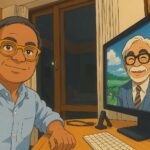Javier Errea, a journalism graduate, is the principal of, Errea Comunicación, a new design studio based in Spain. An Associate Professor at the School of Communication, University of Navarra, he is also the President of the Spanish Chapter of the Society for News Design and coordinator of the Malofiej Infographics World Summit and Competition. He is also a winner of the SND’s Lifetime Achievement Award.He was behind the design of much-acclaimed Portugals “i”.
In this exclusive interview T K Sajeev, Regional director of SND 19 talks with Javier about his new design concept.Javier is visiting India next month for the first news design conference in the Asia Pacific held at New Delhi which is jointly conducted by WAN-IFRA and SND

1. How difficult is it to relaunch a newspaper rather than producing a new one?
It is a little bit different. Easier and more difficult at the same time. Dealing with an existing newspaper means having in mind all the past and history behind. You cannot ignore those previous years and people, the soul of that particular newspaper. You have to learn from that experience and listen carefully to all the people involved. You have to deal always with some kind of resistance. A new newspaper is always exciting, a new adventure, less resistance for sure… You have no references except the market itself and your experience. Both are really exciting. But I would pick up a redesign more than creating a new daily or magazine from scratch.
2. Compared to other countries the Indian newspapers were using more colour and bold types. How do you feel about it?
It is a fantastic cultural immersion. I always say that news design is mainly a question of respect. You cannot fly to a new country and culture taking for granted that you are the expert and that you have the solutions. It is handless like this. I would say that it is just the opposite. News design means listening to people first, looking to every single detail simultaneously, and a humble approach. Of course, clients call you due to your past experience and this is something valuable. Many projects fail due to vanity. I am most proud of some projects developed in such different cultural landscapes as the Gulf area or Eastern Europe. Now in India, trying to learn type, colour, accent etc. Each geographic and cultural areas have their own patterns.I don’t believe in design globalisation.
3.Your team’s creation of Portugal’s “I ” was a revolution. Even after two years, it’s still looking fresh. Can you tell about it? Did your team monitored everything from the newsroom to design?
 We worked with the i team from the very beginning. It was not mainly a design project but a fully journalistic project. I am actually a journalist, not a designer. I worked as reporter and editor in different newspapers for many years. I have never attended any design degree. I am fully convinced that news design is mainly a journalistic tool. We developed the editorial concept and how this concept would be developed by the team with i. The final result is fantastic due to this deep link between journalism and presentation. Best designers in I were not just pure designers but people such as Andre Macedo, deputy editor in chief, a brilliant guy truly convinced that news presentation is not just a key but a must in current journalism. We could speak for hours about i…
We worked with the i team from the very beginning. It was not mainly a design project but a fully journalistic project. I am actually a journalist, not a designer. I worked as reporter and editor in different newspapers for many years. I have never attended any design degree. I am fully convinced that news design is mainly a journalistic tool. We developed the editorial concept and how this concept would be developed by the team with i. The final result is fantastic due to this deep link between journalism and presentation. Best designers in I were not just pure designers but people such as Andre Macedo, deputy editor in chief, a brilliant guy truly convinced that news presentation is not just a key but a must in current journalism. We could speak for hours about i…
4.In a society like India were people have a habit of reading how can a visual journalist excel in limited space that has been provided to him
I like hearing that people are used to reading in India. Newspapers are a crucial communication channel in your country. Newspapers are still a key point within the social debate, the way people are informed, the main channel to share facts and thoughts. Indian market is now a privilege. You just have to compare this situation with Western markets. Limited space shouldn’t be a problem for a news designer ever. News designers must be intelligent enough to take advantage of any situation and improve the quality of the product. What does it mean? Many things. News design is not about aesthetics and superb displays, it is mainly about the news and make people understand reality better.
5. Each of your redesign works were different. What’s secret of making every work totally different?
Thanks for your compliments. We try not to apply kits but to adapt solutions to each newspaper. I know this sounds very commercial but it is true. You cannot copy and paste existing formulas.
6. Once you have done the redesign your role is over. Then how will make you sure that the design is followed throughout.
It is a pity that many news companies consider that the project is over the day after a re-launch. Of course, the hey have to take cost in mind. But any follow up process should be taken and agreed previously because that means a guarantee. We normally do this follow up for a while. It is a key.
7. Now there is a thought that storytelling comes first in newspaper production. Only then design comes. Can you describe it?
I would say that storytelling is the key and that new audiences are demanding a wider variety of storytelling formats, not just a text and picture pattern. There are many other options and we news designers should explore and apply depending on the content.
8. How do you look forward to 2012 Jan. news design conference in India?
It is a privilege to have been invited. An incredible opportunity to better know your country and to learn from Indian designers and journalists. I hope I could learn a lot.
9. Which work do you feel gives you hard time.Why?
Most difficult projects are those demanding magic solutions. Many news companies consider you a magician, and this is not true at all. We are not magicians. We are just professionals. They have to understand this.
10. What an ideal newsroom for a good design/production?
I would say that we should achieve a new role of total journalists, newsrooms where reporters, editors and designers are the same. Of course, we need experts, specialized people, but we, even more, need people understanding each other. Those sensible professionals who understand what other colleagues do is as important as what they do. Collaborative landscape, this is the secret.
See Javier’s more works at http://erreacomunicacion.com
![]()





